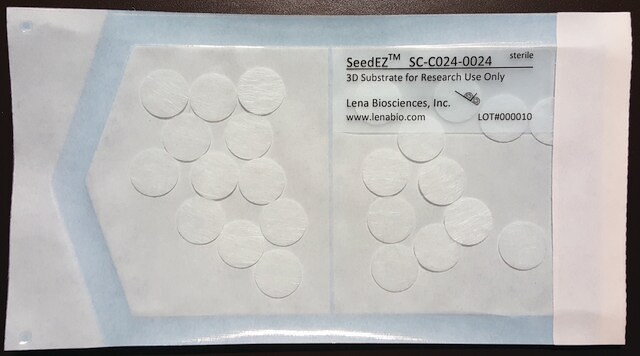Once isolated, organoids are cultured in specialized media embedded in a rich extracellular matrix (ECM) basement membrane extract hydrogel such as Growth Factor Reduced Matrigel. Media is replenished every other day and cells are passaged once per week (7-12 days) before cells become too large or necrotic. Cells can be passaged in either small clump fragments or as single cells using mechanical dissociation/enzyme-free passaging reagents. Depending on organoid type and confluency, split ratios of roughly 1:3-1:4 can be used when passaging organoids. For sensitive organoid types, ROCKi (Y27632) (SCM075) can be added during passaging to help in promoting cell viability.
SCM307
3dGRO® Lung Organoid Branching Medium
Serum-free ready-to-use media used to differentiate anterior foregut endoderm (AFE) cells into lung bud organoids in suspension cultures.
About This Item
Productos recomendados
Descripción general
The 3dGRO® Lung Organoid Branching Medium is a chemically defined/serum-free ready-to-use media used to differentiate Sox2+/Pax6+ anterior foregut endoderm (AFE) cells into lung bud organoids in suspension cultures. Additionally, the 3dGRO® Lung Organoid Branching Medium can be used to culture AFE cells on fibronectin coated cultureware. The 3dGRO® Lung Organoid Branching Medium is a component of the 3dGRO® Human Lung Organoid Culture System which can be used to differentiate human iPS cells into mature lung organoids that structurally resemble the in vivo branching airway and early alveolar structures. The 3dGRO® Human Lung Organoid Culture System includes (all sold separately):
- Definitive Endoderm Induction Medium (SCM302)
- Anterior Foregut Endoderm Induction Medium I (SCM305)
- Anterior Foregut Endoderm Induction Medium II (SCM306)
- 3dGRO® Lung Organoid Branching Medium (SCM307)
- 3dGRO® Lung Organoid Maturation Medium (SCM308)
Human iPSC Derived AFE Progenitors (SCC301)
Almacenamiento y estabilidad
Información legal
Cláusula de descargo de responsabilidad
Código de clase de almacenamiento
10 - Combustible liquids
Clase de riesgo para el agua (WGK)
WGK 2
Certificados de análisis (COA)
Busque Certificados de análisis (COA) introduciendo el número de lote del producto. Los números de lote se encuentran en la etiqueta del producto después de las palabras «Lot» o «Batch»
¿Ya tiene este producto?
Encuentre la documentación para los productos que ha comprado recientemente en la Biblioteca de documentos.
Artículos
Lung organoids are valuable 3D models for human lung development and respiratory diseases. The 3dGRO™ differentiation protocol generates organoids from human iPSCs in 4 steps.
Organoid culture FAQs. Learn how to culture and analyze organoids following established 3D cell culture protocols. Tips and tricks.
Contenido relacionado
Explore our portfolio of 3D cell culture tools and technologies for any 3D cell line or application and discover organoids, hydrogels, ULA, microwell, or hydrogel plates, and more.
-
How are organoids cultured?
1 answer-
Helpful?
-
-
How do you stain organoids with antibodies?
1 answer-
Organoids can be stained with antibodies for immunocytochemical (ICC)/Immunohistochemical (IHC) analysis using either whole-mount or paraffin embedding/sectioning techniques. It is critical to use antibodies prequalified for organoid analysis.
Helpful?
-
-
How Do you Extract RNA/DNA from Organoids in Cultured in Matrigel?
1 answer-
Traditional DNA/RNA isolation kits can be used to prepare genomic material for sequencing (RNA-seq, scRNA-seq, WGS, CHIP-seq etc). For some applications with large organoids, tissue specific DNA/RNA extraction kits are recommended. TRI Reagent (T9424) can be added to the dissociated organoids before RNA extraction and can be stored at -80 °C until future use.
Helpful?
-
Active Filters
Nuestro equipo de científicos tiene experiencia en todas las áreas de investigación: Ciencias de la vida, Ciencia de los materiales, Síntesis química, Cromatografía, Analítica y muchas otras.
Póngase en contacto con el Servicio técnico


![2-ALLYL-6-{[(2-HYDROXYPHENYL)IMINO]METHYL}PHENOL AldrichCPR](/deepweb/assets/sigmaaldrich/product/structures/281/689/39c9e21d-abf2-4cb4-b274-4cf25679fc70/640/39c9e21d-abf2-4cb4-b274-4cf25679fc70.png)
